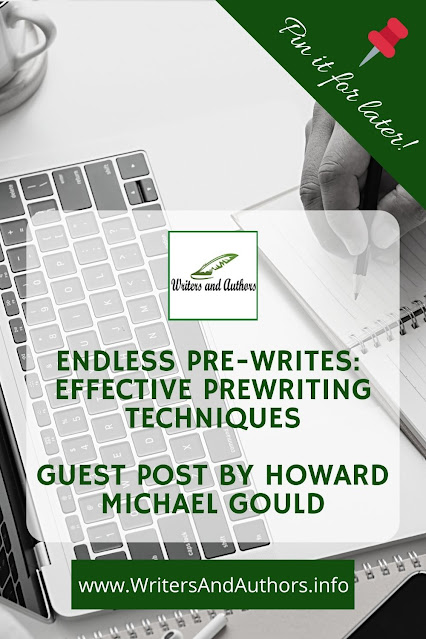Endless Pre-writes
Effective Prewriting Techniques
Guest Post By Howard Michael Gould
 |
| Purchase Links: Amazon | Goodreads |
It began long before I became a novelist. I started as a playwright (college, then off-off-Broadway), then worked successfully in TV audience sitcoms for a decade. Then I wrote another play, which Mike Nichols wanted to direct, which got the attention of the movie side of the business. But the more successful I got, and more importantly, the better I got at my craft—specifically, the more I knew about what a good script actually was—the harder it got for me to actually write. I’d intimidated myself into paralysis. It was hell.
I came to think of it as page fright.
I still have it. And I still think of all I’m about to describe as a workaround. But it’s an effective one.
When I start a new project, whether it’s a movie rewrite or my own novel from scratch, I start by opening a Word document, and just talking to myself, doing all my thinking is on paper (well, pixels).
At some point—and if it’s a novel, this may be weeks in—I have an idea of some things I know. So I’ll list them. But what’s more glaring and scary, of course, is how very much I don’t know. So I’ll make a list of questions. Where’s the action? Which characters from the last book are in this one? Do we need another dead body somewhere? Usually they’re pretty general at this point.
When that document becomes too cumbersome, I’ll open a second—called “Notes2”—and start again by taking stock of what I have, and what I don’t. A new set of questions, becoming more granular. How does Waldo know his client is lying? How many suspects are there? How does he figure out who the killer is?
For the fourth Waldo novel (in progress), I had four of these documents, totalling 150 single-spaced pages… before I even started outlining.
Once I’ve answered every question I can think of, I start putting everything on index cards. When I started in TV, we used real index cards on a cork board. (For the last 25 years I’ve been addicted to software called Writer’s Blocks. If they ever go out of business, I’ll have to retire.) I use different colors for different storylines, and put absolutely anything that I think might go into the book onto a card. For the Waldo in progress, there were around 350 of them.
The next step is putting those cards in order, a daunting task. Here the screenwriting background helps. Mainstream movies traditionally have major story turns at the ¼, ½, and ¾ points. I think of my Waldo books as sort of overstuffed screen stories, and put the major turns of each storyline at about those marks, so the cards naturally group roughly into more manageable quarters. I order each of those quadrants, then further divide each into chapters.
That done, I use the “manuscript” function in Writer’s Blocks to turn it all into text, and import it into a new Word document, which I’ll expand into my outline.
To do that, I flesh out each chapter from the list of index card thumbnail notes into a detailed telling. I write in unabashedly clunky prose, in present tense—vestigial from my screenwriting years—and throw in everything I can think of, and grind on anything that might slow me down later. If I’ll need to do some research, this is the time. If I know I’m going to need to refer to a previous Waldo book, I’ll note the exact spot here. The idea is to do every bit of work that I can, before the scary parts starts.
This phase alone can take me months. It usually yields about 70 single-spaced pages, or 30,000 words, toward a novel which will run 70,000 to 75,000.
When I get through that… at last, it’s time to brave the blank page. But with a hell of a head start.
One famous writer-director I collaborated with laughed when I told him about my process. He said, “You’re tricking yourself into writing while you’re telling yourself you’re not writing.”
Maybe he’s right. But at this point, it’s the only way I know how to get through it.
His play DIVA premiered at the Williamstown Theatre Festival and La Jolla Playhouse, and was subsequently published by Samuel French and performed around the country.
He is the author of three mystery novels featuring the minimalist detective Charlie Waldo: LAST LOOKS (2018) and BELOW THE LINE (2019), both nominated for Shamus Awards by the Private Eye Writers of America, and PAY OR PLAY (2021). The feature film version of LAST LOOKS, starring Charlie Hunnam and Mel Gibson and directed by Tim Kirkby, will premiere February, 2022; Gould also wrote the screenplay.














0 Comments
I love to hear from you. So feel free to comment, but keep in mind the basics of blog etiquette — no spam, no profanity, no slander, etc.
Thanks for being an active part of the Writers and Authors community.